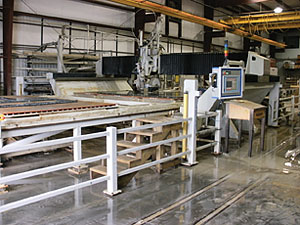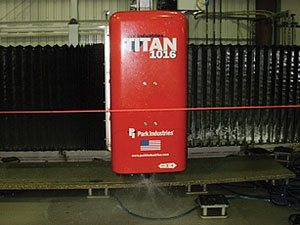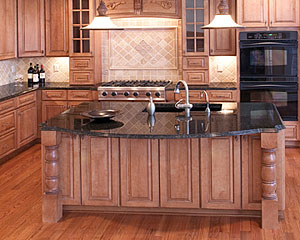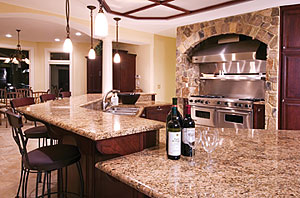
After completing a 12,000-square-foot expansion,
Capitol Granite & Marble in Midlothian, VA, recently added new machinery,
including a Park Fusion 8000 CNC combination bridge saw/waterjet and a Titan
CNC stoneworking center - both from Park Industries of St. Cloud, MN.
When Stone World first wrote about Capitol Granite & Marble in March of 2006, the company was in the process of a $2.5 million expansion, which included new machinery and a 12,000-square-foot addition to its facility. Now, Capitol Granite & Marble, which is located in Midlothian, VA, has continued on the path of expansion, in specifically its equipment line. Recent investments have given the company a complete digital transformation - which owner Paul Menninger states is vital in this day and age to survive a stone fabrication business.

With the addition of its new machinery, the shop now
has “the digital advantage,” according to company owner Paul Menninger.
Today, with the addition of a Fusion 8000 CNC combination bridge saw/waterjet and a Titan 1016 CNC stoneworking center - both from Park Industries of St. Cloud, MN - Menninger is able to stand behind these principles more than ever. The shop had already been equipped with a Flow waterjet from Flow International Corp. of Kent, WA, a Velocity edge processor, three CNC stoneworking centers, including a Discovery and two Odysseys, a Yukon bridge saw, two Pro-Edge automatic edge polishers, a Wizard radial arm polisher and a Fastback flat edge polisher - all from Park Industries.

The Fusion was added in order to change the way the
company handles production, allowing Capitol Granite & Marble to replace
85% of the cuts it was doing on its waterjet. “It made the cutting four times
faster than the waterjet at a fraction of the cost,” said Menninger.

“Because of the sawjet, we’re not only able to cut
fast, we can cut accurately,” said Menninger of the Fusion. “So we’re picking
up CNC time because we don’t need milling bits. We go straight to profile
cuts.” The machine uses tooling from Continental Diamond Products, Inc. of San
Carlos, CA.
Advantages of the added machinery
For Menninger, the Titan was added to increase production, while the Fusion was added in order to reach a higher level of efficiency.“The beauty of [the Titan] is when the day is done, the last thing we do is load it up with the most difficult job of the day,” he said. “We hit the start button, turn off the lights and lock up. Our day extends four to five hours in the night, allowing the machine to run with no one around.”

The Titan was added to the shop to increase
production, and it features ADI tooling from GranQuartz of Tucker, GA.
Aside from the increased production capabilities given by the Titan, the Fusion has allowed the company to replace 85% of the cuts it was doing on its waterjet. “Unless the job is 100% curves, I can’t think of a reason why we would ever process [solely] on a waterjet,” said Menninger. “It made the cutting four times faster than the waterjet at a fraction of the cost.

“The beauty of it is when the day is done, the last
thing we do is load up the Titan with the most difficult job of the day,” said
Menninger. “We hit the start button, turn off the lights and lock up. Our day
extends four to five hours in the night, allowing the machine to run with no
one around.”

Capitol Granite & Marble completes an array of
work, including countertops for residential projects.
Having prior experience with a waterjet, the learning curve for the Fusion was minimal. “Because we had already had waterjet experience, the learning curve was about three weeks,” said Menninger. “Park’s ability to train people is uncanny. It’s very simple to use. Programming the machine is easy. It’s the easiest machine in the shop to run.”

The company utilizes Moraware’s JobTracker software to
help manage jobs and inventory (an example of which is pictured).
Menninger went on to explain that the performance of the saw/waterjet goes hand in hand with the blades used from Continental. “The nice thing about the Fusion is it actually gives us actual time in stone cutting hours because of its automation capabilities,” he said. “Now I can determine how many cutting hours in the stone I get out of a cutting blade. We’re able to figure out and determine our costs per hour of a given blade. [Continental’s] blades are not the cheapest, but are still the best value. They cut true and fast, and I’m getting on average 21 hours in one blade on the stone. At the $400 price point, there is not a cost per hour that I have found that can compare. The average blade in the marketplace is running 10 to 14 hours.”

The company currently produces approximately 900 to
925 square feet of material a day, but it has the ability to produce 2,000
square feet.
The market advantage
According to Menninger, knowing the specific costs to machinery and their tooling, and the amount of time they’re able to run are all a part of what gives a digital shop an advantage. “You have to know what your costs are in the Titan and the Fusion,” he said. “If you don’t have your costs under control by virtue of digital age, then you’re not going to accurately bid a job.“In the digital age, I can’t understand how a shop can operate without a digital transformation,” he continued. “If you take a look at the woodworking industry and any other industry like this, they’ve all gone to digital technology and processing. Granite is behind, but is catching up. The precedent has been set. Those who have not made the transformation, they’re behind. Those who have, need to relish the information.”
Menninger highlights utilizing the digital age by automatically and accurately collecting data. “Understand where your costs are now so you can go forward and accurately bid work and make money,” he said. “If we’re not taking advantage of sawjets, digital technology and CNCs, and being able to extract profitability out of the shop, then you’re behind and you’re going to get run over by shops that are.”

Current production
Quartz surfacing, such as lines from Silestone, Zodiaq and Cambria currently make up a third of Capitol Granite & Marble’s business, and the shop is currently working on several commercial projects, including an apartment complex and a medical facility.The shop has the ability to produce 2,000 square feet of material a day, but currently produces 900 to 925 square feet under a staggered shift. “The shop is running about 14 hours a day in split shifts,” said Menninger. “It’s not a full-blown two shifts, just a shift and a half. As we get more capacity, we are splitting the shifts apart. We have some overlap of what we’ve got going on right now.”
Among the shop’s achievements, Capitol Granite & Marble is a Marble Institute of America (MIA) Accredited Natural Stone Fabricator. Menninger additionally was the recipient of Stone World’s Stone Fabricator of the Year Award in 2008.
Capitol Granite & Marble
Midlothian, VAType of work: Commercial and residential stone fabrication, including one-third quartz processing
Machinery: a Fusion 8000 CNC combination bridge saw/waterjet, a Titan 1016 CNC stoneworking center, a Velocity edge processor, three CNC stoneworking centers, including a Discovery and two Odysseys, a Yukon bridge saw, two Pro-edge automatic edge polishers, a Wizard radial arm polisher and a Fastback flat edge polisher - all from Park Industries of St. Cloud, MN; a Flow waterjet from Flow International Corp. of Kent, WA; tooling from Continental Diamond Products, Inc. of San Carlos, CA; CNC tooling from ADI, purchased from GranQuartz of Tucker, GA; electronic templating equipment from Faro Technologies Inc. of Lake Mary, FL; Moraware JobTracker software from Moraware of Reno, NV
Number of employees: 60
Production capacity: 900 to 925 square feet of material a day, but capacity for 2,000 square feet
Master bathrooms make up some of the work the company completes.
Capitol Granite & Marble
Midlothian, VA
Type of work: Commercial and residential stone fabrication, including one-third quartz processing
Machinery: a Fusion 8000 CNC combination bridge saw/waterjet, a Titan 1016 CNC stoneworking center, a Velocity edge processor, three CNC stoneworking centers, including a Discovery and two Odysseys, a Yukon bridge saw, two Pro-edge automatic edge polishers, a Wizard radial arm polisher and a Fastback flat edge polisher - all from Park Industries of St. Cloud, MN; a Flow waterjet from Flow International Corp. of Kent, WA; tooling from Continental Diamond Products, Inc. of San Carlos, CA; CNC tooling from ADI, purchased from GranQuartz of Tucker, GA; electronic templating equipment from Faro Technologies Inc. of Lake Mary, FL; Moraware JobTracker software from Moraware of Reno, NV
Number of employees: 60
Production capacity: 900 to 925 square feet of material a day, but capacity for 2,000 square feet